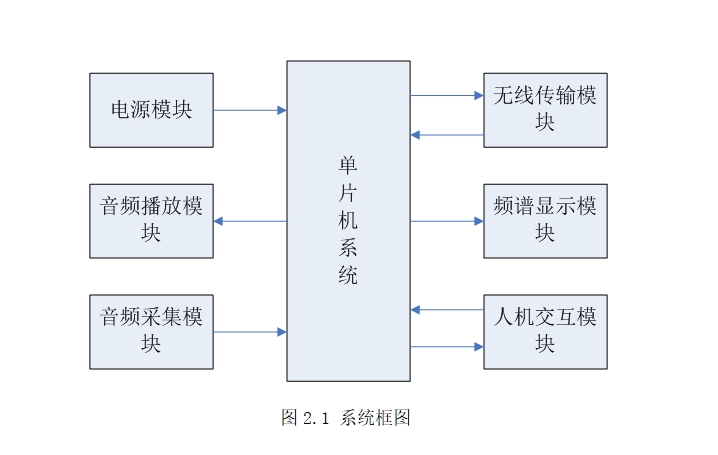基于蓝牙通信模块的无线音箱设计

基于蓝牙通信模块的无线音箱设计(任务书,开题报告,外文翻译,论文10900字)
摘 要
随着智能手机的大范围普及,其配件设计也愈发受到关注,无线音箱便是其中比较成熟、使用广泛的产品之一。本设计是一款以蓝牙通信模块为核心的无线音箱,主要功能有:通过蓝牙播放来自手机本地的音乐,播放独立SD卡中的音乐,以及通过音频线播放来自电脑等外部设备的音乐,在本系统的触摸屏上实现音乐频谱的显示和接电话、调节音量和歌曲切换等功能。
本系统的工作原理是通过蓝牙将手机中的音乐信号传送到音箱,经过音频功放电路放大后采用扬声器进行播放,并将音乐信号传递给STM32开发平台通过音频程序中的FFT变换部分对信号进行频谱分析并将结果传递给触摸屏,以彩色光柱效果进行频谱显示,同时通过触摸屏和蓝牙模块的通信完成接电话和歌曲切换等操作。
关键词:蓝牙 STM32 频谱 音乐播放 触摸屏
Design of the wireless sound box based on Bluetooth communication module
Abstract
With the popularity of smart phones, the fittings of the smart phones are also increasingly subject to attention and wireless sound box is the one of the more mature, widely used products. This design is a wireless sound box with the Bluetooth communication module as the core, and its main functions include: playing the music from the mobile phone and the SD card by Bluetooth, and play music from the computer and other external devices through the audio line,achieving music spectrum display on the touch screen and answering the phone, adjusting volume and switch songs etc. [资料来源:http://Doc163.com]
The operational principle of the system is transmitting music signal of phone to the speaker by Bluetooth, and plays the music signal by the speaker after audio power amplifier circuit amplifies it; then the music signal is transferred to the STM32 development platform and analyzed by the FFT program,and afterwards the result is passed to the touch screen, showed by the colorful light beam; at the same time, the system finishes the function of answering the phone, switching songs and other operations.
Keyword:Bluetooth; STM32; Frequency spectrum; Music playing; Touch screen
[资料来源:http://www.doc163.com]


目 录
摘 要 I
Abstract II
第一章 绪论 1
1.1 研究背景和意义 1
1.2 国内外研究现状 1
1.3 本文内容与结构 2
第二章 系统总体方案设计 4
2.1 总体方案 4
2.2 单片机模块选择 4
2.3 无线传输模块选择 5
2.4 触摸屏模块选择 5
2.5 MP3芯片选择 6
2.6 电源模块选择 6
2.7 小结 7
第三章 系统硬件电路设计 8
3.1 单片机最小系统 8
3.1.1 单片机时钟电路 8
3.1.2 复位电路 9
3.2 蓝牙通信电路 9
3.3 音频功放电路 10
3.4 AUX连接电路 11
3.5 MIC输入电路 11
3.6 触摸屏电路 11
3.7 音频播放单元 12
3.8 SD卡播放电路 13
3.9 小结 13
第四章 系统软件部分设计 14
4.1 系统总程序 14
4.2 显示部分 15
4.2.1 频谱原理 15
4.2.2 频谱显示主程序设计 15
4.2.3 显示子程序设计 16
4.3 触摸屏部分 17
4.3.1 触摸屏主程序设计 17
4.3.2触摸屏子程序设计 18
第五章 系统调试与总结 20
[资料来源:www.doc163.com]
5.1 硬件调试 20
5.2 软件调试 20
5.3 系统运行结果 21
5.4 总结 22
参考文献 23
附录 25
致谢 26
[来源:http://Doc163.com]
